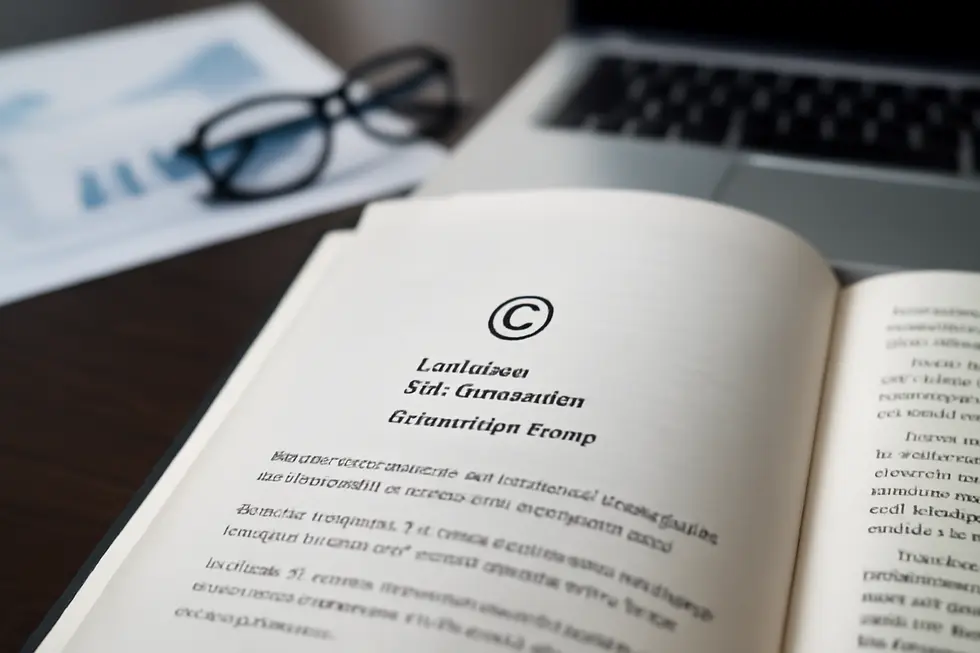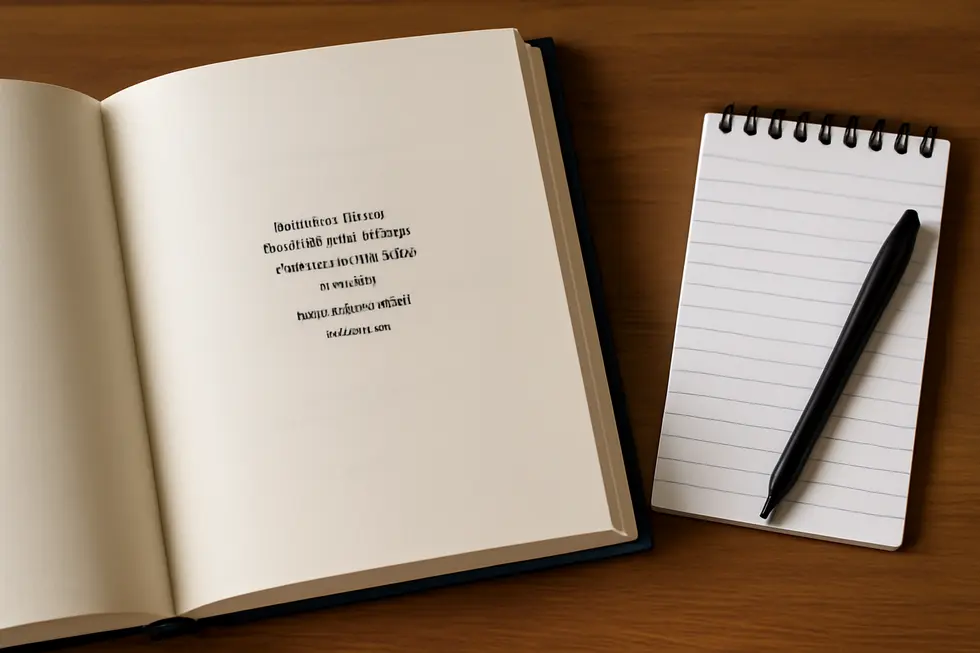Introdução
The book copyright page is a crucial yet often overlooked component of any published work. For business owners venturing into authorship or publication, understanding this page is key to safeguarding intellectual property and enhancing a book’s professional credibility. The copyright page serves as the formal declaration of ownership and provides vital publication details that protect and identify your work. This article explores the book copyright page in three focused chapters: first, outlining the legal and technical elements necessary to assert your rights; second, detailing the publishing and bibliographic information that authenticates your book’s provenance; and third, clarifying formatting standards and best practices that meet industry expectations and support your book’s professionalism. By grasping these interconnected facets, business owners can confidently navigate the nuances of book publishing and intellectual property protection.
Tabelas de conteúdos
Chapter 1: Legal and Technical Elements of the Book Copyright Page
- Crafting the Copyright Notice: Essential Legal Statements and Requirements
- Precise Placement and Professional Formatting in Book Copyright Pages
- Essential Legal Notices and Technical Clarifications on the Copyright Page
Chapter 2: Publishing and Bibliographic Details on the Book Copyright Page
- Understanding Copyright Notice and Ownership: Core Elements on the Book Copyright Page
- Defining Publisher Identity and Edition Specifics: Keys to Accurate Bibliographic Record on the Copyright Page
- Integrating Legal Disclaimers, ISBNs, and Compliance in Book Copyright Pages
Chapter 3: Formatting Standards and Best Practices for the Book Copyright Page
- Optimizing Placement and Layout for a Professional Copyright Page
- Essential Content and Layout Principles for an Effective Copyright Page
- Optimizing Typography and Layout for Clear, Professional Copyright Pages
Chapter 1: Legal and Technical Elements of the Book Copyright Page

1. Crafting the Copyright Notice: Essential Legal Statements and Requirements
A book’s copyright page is crucial in asserting and communicating legal ownership of the work. Central to this page is the copyright notice, a formal declaration that must include three core elements: the © symbol (or the word “Copyright” or its abbreviation “Copr.”), the year of the book’s first publication, and the name of the copyright holder. This notice publicly marks the work’s protected status and the initial publication date, which can be significant in legal proceedings involving infringement.
While copyright protection automatically applies upon the fixation of a creative work, the notice strengthens the author’s claim by clearly stating ownership. Also, registration with the U.S. Copyright Office, though optional, further enhances legal protection by enabling statutory damages claims and attorney’s fees if infringements occur.
In addition to the copyright notice, the copyright page often contains rights reserved statements, disclaimers, licensing information, and sometimes detailed contact addresses to direct copyright claims or Digital Millennium Copyright Act (DMCA) notices. These technical and legal components not only safeguard the author’s intellectual property but also provide necessary clarity for publishers, readers, and legal authorities. Proper formatting—traditionally smaller font aligned bottom-left on the verso immediately after the title page—ensures the information is accessible yet subtly integrated into the book’s front matter.
For authoritative guidelines and templates on structuring these legally sensitive pages, exploring specialized resources can simplify compliance and enhance protection. More details on book copyright notices offer practical insights into their importance and construction.
2. Precise Placement and Professional Formatting in Book Copyright Pages
The copyright page holds a distinct place within a book’s front matter, traditionally found immediately after the title page on the left-hand (verso) side. Known as the reverse title page, its placement conforms to the publishing standard where odd-numbered pages appear on the right (recto) and even-numbered on the left. This positioning ensures the copyright information is one of the first legal notices a reader encounters while maintaining a professional and familiar layout.
Formatting the copyright page also follows established conventions important to clarity and formality. Typically, the text aligns to the bottom-left corner of the page in print editions, distinguishing it visually from the main body text. The font size is reduced relative to the book’s primary content, signaling that this page serves a legal and informational function rather than narrative or promotional content. Unlike other front matter pages, running heads or page headers are generally omitted from the copyright page to maintain a clean, focused presentation.
This page aggregates critical legal elements such as the copyright notice (© symbol, year, and copyright holder’s name), an “all rights reserved” statement, ISBN and cataloging metadata, publisher details, disclaimers, and credits for permissions. While no strict legal order governs their presentation, clear, consistent formatting upholds industry norms and conveys professionalism. These details work together to authenticate the book’s origin and establish its intellectual property protections.
For those seeking formatting guidance, specialized tools offer templates that automatically apply these conventions, ensuring the copyright page meets legal and industry expectations.
External guidance like Kindlepreneur’s copyright page formatting advice provides comprehensive templates and best practices.
3. Essential Legal Notices and Technical Clarifications on the Copyright Page
A book’s copyright page plays a critical role beyond simply stating ownership; it also clarifies the scope of rights and the technical nature of included content. Traditionally, the page features a copyright notice composed of the © symbol, the first publication year, and the name of the copyright holder. This symbol signals legal protection, distinguishing visually perceptible copies from others like audio recordings, which use the ℗ symbol instead.
Accompanying the notice is a rights statement that defines whether all rights are reserved or if certain permissions are granted. This declaration informs readers and potential users about limitations or allowances for reproduction, distribution, or adaptation. In some cases, registration information such as the copyright registration number is presented to reinforce legal validity, although registration itself is a separate process from the notice.
Permissions and disclaimers often follow, specifying fair use exceptions or liabilities the publisher disclaims. These legal notices protect the author and publisher while guiding acceptable uses of the text.
From a technical standpoint, the page may clarify copyright status regarding included standards, charts, or factual data. Government standards are commonly public domain, and factual tables are not typically protected by copyright since they convey information without original authorship. Such clarifications prevent confusion about what content is freely usable versus protected.
The formatting remains consistent, usually appearing immediately after the title page, with a smaller font and aligned toward the bottom left to maintain readability while not distracting from other front matter.
For deeper insight into crafting a compliant copyright notice, reviewing authoritative guidelines such as those from legal experts is invaluable. Learn more about how to properly construct your book’s copyright notice. An external resource providing detailed guidance on copyright page content can be found via the U.S. Copyright Office.
Chapter 2: Publishing and Bibliographic Details on the Book Copyright Page

1. Understanding Copyright Notice and Ownership: Core Elements on the Book Copyright Page
The copyright notice is a pivotal component on the copyright page, typically found on the verso side opposite the title page. It formally establishes legal ownership by displaying the © symbol, the year of first publication, and the name of the copyright holder, usually the author or publisher. This notice clarifies when rights began and who controls them, securing the work against unauthorized use. Positioned in smaller font near the page’s bottom-left in print editions, it follows a standardized format that publishers and authors consistently adhere to.
Beyond the copyright notice, this page often includes essential rights statements such as “All rights reserved,” which affirm the scope of legal protections granted. Licensing terms or permissions might also be listed when applicable, informing readers and distributors about permitted uses.
Bibliographic details complement these legal declarations, appearing both on the title and copyright pages to support accurate identification and citation. Elements like the book’s title, subtitle, author names, publisher’s name, edition, and publication year ensure clarity about the version and provenance.
Together, the copyright notice and bibliographic information fulfill dual roles: safeguarding intellectual property while providing authoritative reference data. This synergy is crucial for legal clarity and facilitates reliable citation by readers, librarians, and researchers. For further insight into copyright notices in publishing, see book copyright notice business.
2. Defining Publisher Identity and Edition Specifics: Keys to Accurate Bibliographic Record on the Copyright Page
The publisher identity and edition specifics on the copyright page serve as the primary indicators that clarify exactly which version of a book is being referenced and who is responsible for its publication. Typically situated right after the title page, this information ensures precise bibliographic documentation and supports copyright clarity. The publisher’s name is prominently listed to identify the entity behind the book’s production and distribution. This identification helps readers, libraries, and legal entities trace the book’s origin and authenticate its source.
Edition specifics, such as “2nd edition” or “Revised edition,” are vital to distinguish between multiple printings or versions, reflecting updates, corrections, or new content. Alongside the edition label, the year of publication for that particular edition contextualizes its release timeline, separate from the original copyright year. The copyright notice conventionally includes the © symbol followed by the year of initial publication and the name of the copyright owner—usually the author or publisher—to assert legal ownership.
For proper citation in styles like APA or Bluebook, accurate publisher and edition details recorded on the copyright page enable correct referencing, critical for academic, legal, and bibliographic usage. The formatting may vary by publisher style but usually appears in a smaller font near the bottom of the page, balancing readability with legal formality.
Together, these elements confirm the authenticity and version history of a book, essential for protecting intellectual property and ensuring accurate bibliographic control. For more detailed insights into copyright registration and notices, resources like Kindlepreneur provide comprehensive guidance.
3. Integrating Legal Disclaimers, ISBNs, and Compliance in Book Copyright Pages
The book copyright page serves as the authoritative legal anchor for a publication, integrating essential information that legally protects and identifies the work. Central to this page is the copyright disclaimer, which includes the © symbol, the year of first publication, and the copyright holder’s name—commonly the author or publisher. This disclaimer asserts ownership and exclusive rights, deterring unauthorized use even though copyright exists automatically upon creation. Alongside this, ISBNs (International Standard Book Numbers) are prominently displayed. These unique identifiers facilitate global cataloging, sales, and distribution, appearing both on the copyright page and the back cover to ensure consistent bibliographic recognition.
Legal disclaimers further clarify rights and limitations, often addressing permissions, liabilities, and the scope of use. Additionally, many jurisdictions impose legal deposit requirements obligating publishers to submit copies to designated libraries for preservation and public access. For instance, Australia mandates the deposit of print and digital formats without DRM restrictions, reflecting evolving digital publishing norms.
Formatting of this page typically involves a smaller font, placed immediately after the title page, and aligned at the bottom-left on print editions to distinguish it clearly as front matter. This harmonized presentation pairs legal precision with practical bibliographic function, ensuring the page fulfills its role in enforcing rights, supporting distribution, and complying with national deposit laws. For comprehensive formatting guidance and legal notices, consulting specialized resources like Kindlepreneur and professional legal advice is recommended.
Chapter 3: Formatting Standards and Best Practices for the Book Copyright Page

1. Optimizing Placement and Layout for a Professional Copyright Page
The copyright page holds a crucial position in a book’s front matter, commonly located immediately after the title page on the left-hand (verso) side. This placement is deliberate, ensuring copyright details are among the first pieces of legal and publishing information a reader encounters. Typically formatted with a smaller font than the main text and aligned near the bottom-left of the page, this subtle design balances legal clarity with unobtrusive aesthetics. Some publishers may choose center alignment for visual symmetry, but bottom-left remains the industry norm.
This page consolidates all essential information—copyright notice, year of first publication, author or holder’s name, publisher contacts, ISBN, edition data, and legal disclaimers—while generally omitting page numbers for the front matter to maintain clean progression into the book’s body. For specialized formats such as children’s picture books, placement nuances adapt to pagination constraints, often appearing on page 2 or 4 to preserve standard spreads and ensure barcode placement.
Maintaining a consistent layout fosters professionalism and readability, meeting both legal requirements and reader expectations. Utilizing standard serif fonts and avoiding clutter further contributes to the page’s function as a clear statement of ownership and publication details. For detailed guidance, publishers often reference expert resources that outline these conventions, ensuring compliant, polished copyright pages that align with industry best practices.
For more on how to correctly draft your copyright notice, see Kindlepreneur’s guide on how to copyright a book.
2. Essential Content and Layout Principles for an Effective Copyright Page
The copyright page plays a pivotal role in establishing a book’s legal and publishing framework. Typically situated on the verso page following the title page, it contains key elements that unequivocally state copyright ownership while providing critical publishing data. The fundamental content includes the © symbol, the year of first publication, and the copyright holder’s name, often the author or publisher. This trio forms the core copyright notice, clarifying who holds the rights and when protection began. Complementing this is an “All rights reserved” statement or explicit licensing terms, especially when special permissions like Creative Commons licenses apply, reinforcing usage restrictions.
Publisher details—name and address—offer transparency about the book’s origin and contact points. The International Standard Book Number (ISBN) is another crucial element, functioning as a unique identifier for the book edition, facilitating distribution and cataloging. Edition and printing details also appear here, distinguishing between first editions or subsequent printings, which is vital for collectors and bibliographers. Additionally, the copyright page often houses disclaimers addressing content accuracy or fictionalization, as well as credits for illustrations, cover art, fonts, and trademarks, thereby acknowledging all creative contributors and proprietary materials.
The page design favors clarity and professionalism, using smaller, readable fonts and bottom-left alignment typical in print books to keep the layout clean and accessible. This formatting helps the page serve both legal and practical purposes without distracting from the book’s primary content. Authors and publishers benefit greatly from adhering to these established standards, ensuring their intellectual property is properly protected while maintaining a polished presentation. For a comprehensive guide on copyright notice formats and layout techniques, consult expert resources such as Kindlepreneur’s detailed copyright page instructions.
3. Optimizing Typography and Layout for Clear, Professional Copyright Pages
The typography and layout of the book copyright page play a vital role in ensuring clarity and professionalism while meeting legal standards. Positioned immediately after the title page, this page typically uses a font size smaller than the main text, striking a balance between distinction and readability. Serif fonts like Times New Roman or Garamond are preferred for their timeless readability, though clean sans-serif fonts may be used if consistent with the book’s overall design. Avoiding decorative or ornamental fonts is essential to preserve the page’s serious and legal tone.
Text alignment commonly favors the bottom-left corner rather than centered or fully justified alignment to prevent awkward spacing and enhance readability. The content must be presented concisely without clutter: it includes the © symbol, the year of first publication, the copyright holder’s name, publisher details, ISBN, edition information, and any applicable legal disclaimers or permissions. Maintaining consistent one-inch margins with appropriate line spacing prevents crowding, allowing readers and legal professionals to easily absorb the information.
Professional typesetting advice emphasizes clear, simple formatting over ornamental design, focusing on presenting critical legal details neatly and accessibly. Authors and publishers can reference reputable guidelines and templates to achieve a refined copyright page that meets industry norms while supporting intellectual property protection. For a comprehensive overview of best copyright practices, the resource on how to copyright a book oferece informações valiosas.
Considerações finais
The book copyright page is a pivotal element that every business owner involved in publishing must understand and apply correctly. It functions as the formal legal shield establishing ownership through clear copyright notices while supplying essential publishing details like the ISBN and publisher information that authenticate the work’s origin. Additionally, applying proper formatting standards ensures the page aligns with industry expectations, enhancing the professional presentation of the book. Together, these facets empower business owners to protect their intellectual property robustly, facilitate book distribution, and affirm their authority over the content. Mastery of the copyright page’s legal, bibliographic, and formatting dimensions is a smart investment that safeguards your creative and commercial interests for the long term.
Obtenha a sua marca registada hoje! Milhares de pessoas protegeram a sua marca através do registo de uma marca registada. De que está à espera? Inicie o seu pedido de registo de marca!
Sobre nós
The globe’s top website for registering trademarks and safeguarding your brand, name, logo, or slogan. We provide an easy, reliable platform for business owners to secure their intellectual property rights and protect their unique identity in the marketplace.







